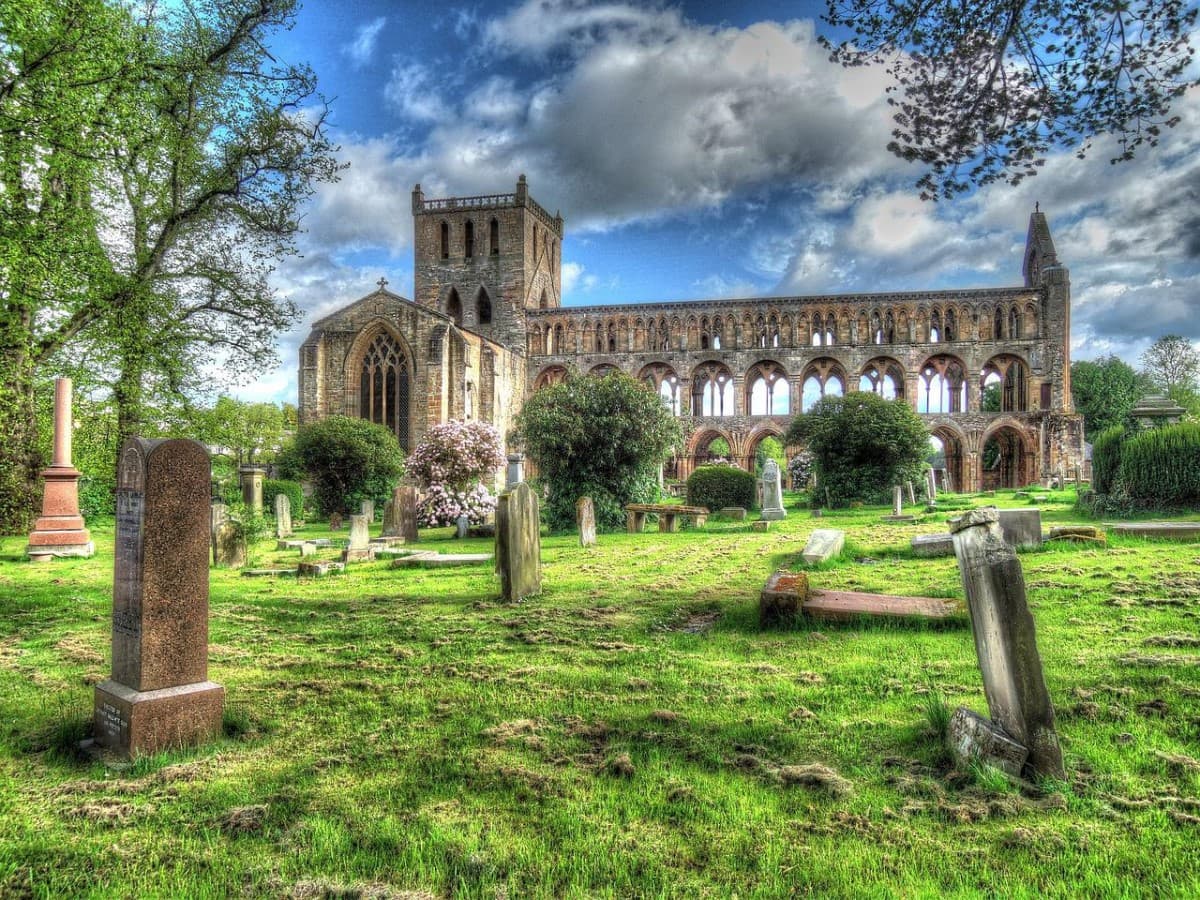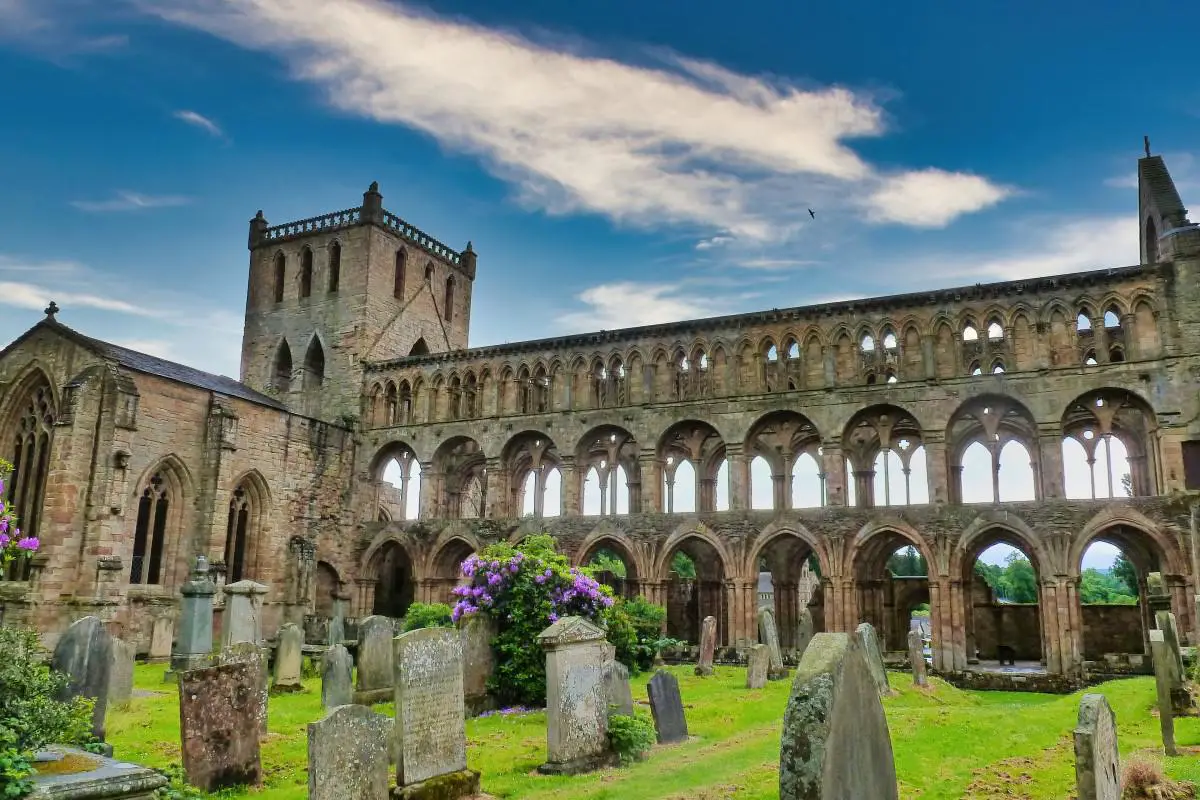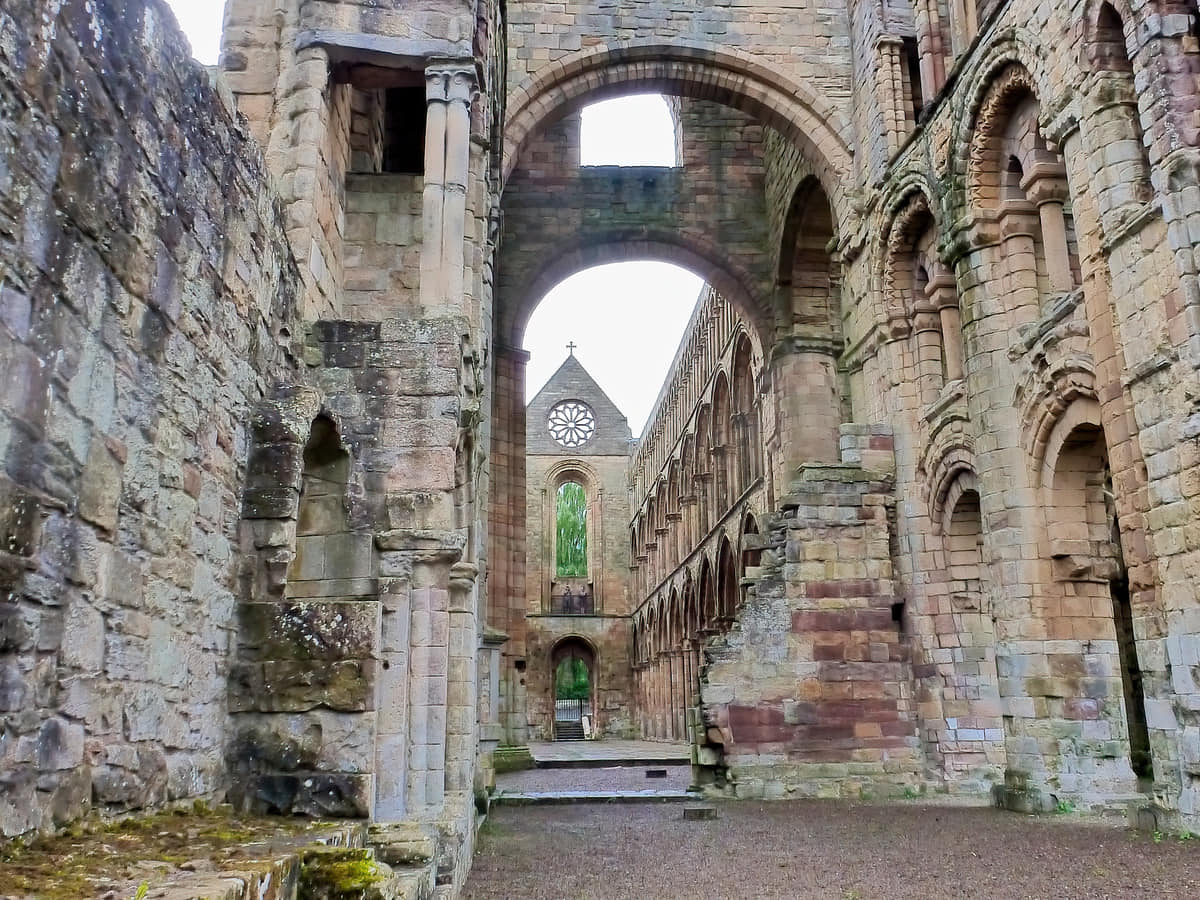Jedburgh Abbey is a magnificent ruined Augustinian abbey located in the town of Jedburgh, in the Scottish Borders. King David I of Scotland founded it in the 12th century, and while it was an active monastery, it housed Augustinian canons who were involved in the local community, offering services like education and hospitality.
Today, visitors can explore the remains of the abbey, a cloister, and domestic buildings, as well as a visitor centre that houses an interesting collection of artefacts found during excavations. Historic Environment Scotland is in charge of managing the abbey which is accessible to the general public year-round.

| Address: | 4/5 Abbey Bridgend, Jedburgh, Roxburghshire, TD8 6JQ |
| Opening Hours: | 1 Apr to 30 Sept: Daily, 10 am to 5 pm Last entry 4.15 pm 1 Oct to 31 Mar: Daily, 10 am to 4 pm Last entry 3.30 pm |
| Admission Price: | Adult £7.00 Child £4 Senior £5.50 |
| Parking: | Paid car parks in Jedburgh |
| Contact: | 01835 863 925 |
| Facilities: | Toilets, shop, disabled access, bike rack, picnic area, water refill, visitor centre |
Overview
Jedburgh Abbey is a ruined Augustinian abbey in the pretty market town of Jedburgh in the Scottish Borders. The abbey is one of four that were established in the Borders in the 1100s, and while it’s mainly in ruins today, its scale and beautiful blend of Gothic and Romanesque architecture make it a must-see attraction for anyone with an interest in historic buildings.
Historic Environment Scotland (HES) has installed a visitor centre that serves to educate tourists about the importance of the abbey in Scotland’s religious past while also entertaining families with a miniature version of the abbey, authentic dress-up clothing, a gift shop, and facilities like bike storage, toilets, and picnic benches.
When visiting Jeburgh Abbey, you’ll be astounded by the splendour of its architecture, especially the church, cloister, and domestic buildings. In addition, the abbey is set within a lovely garden and graveyard which are perfect places for a leisurely stroll.

Book Tours in Scotland
The Highlights
1: Jedburgh Abbey is a beautiful ruin that’s fun to explore, especially for children. Ask the ticket office for a children’s fact-finding quiz when you enter.
2: There’s a lot of information to discover in the visitor centre. Likewise, the information boards dotted around the site are full of fascinating snippets about the history of the abbey.
3: Jedburgh and the surrounding area are jam-packed with picturesque walking trails. If you’d like to know which routes are best, I recommend getting an OS Maps subscription.
Visiting Tips
1: There are guided tours available that can provide a wealth of information about the history and architecture of the Abbey. Audio guides are also available in different languages.
2: The best time to visit Jedburgh Abbey is during the summer months when the weather is warmer. The Abbey is open year-round, but opening hours may vary depending on the season.
3: The Scottish Borders is filled with lots of attractions. If you’re planning a sightseeing tour, make sure to visit the Borders Textile Towerhouse, Melrose Abbey, and the Mary Queen of Scots Visitor Centre.

Protect Your Family From Scotland's Biting Midges
- Powerful, reliable protection for up to 8 hours
- Water- and sweat resistant
- Repels midges, mosquitoes, horse flies, sand flies, fleas and ticks
- Safe for use on adults, children over 30 months and pregnant women
- Non-sticky, moisturising with a pleasant fragrance
- Packaging may vary
Tourist Information
Today, visitors can not only explore the abbey ruins but also wander through the ancillary buildings where the monks would have eaten, slept, and worked in the enormous kitchens, accommodation blocks, and cellars that were needed for an abbey of this size to function. There’s also a faithfully recreated cloister garden which is much the same as it would have been over 800 years ago, with sweet-smelling herbs and flowers filling the air as you make your way through it.
Lastly, there’s a visitor centre that contains lots of information and displays about the history of the abbey, as well as a selection of interesting objects from the days when the monks inhabited the site.
Facilities are good, with toilets in the visitor centre along with a small shop, but there’s no café, so if you’re feeling peckish you’ll need to go elsewhere. If you’ve brought a picnic with you, you’ll find picnic benches in the abbey grounds, or you can head into Jedburgh for a bite to eat in one of the many coffee shops in the town centre.

History
The abbey took more than 70 years to build, and once you step foot inside the great hall, it’s easy to see why. Giant columns of carved stone swoop up into the air so high that you struggle to take them all in, while huge archways line the hall along enormous walls that instantly bring Rome’s Colosseum to mind. This is one religious site that was obviously built to impress, and that’s a feat it accomplishes very well even today.
Jedburgh Abbey actually started life with the slightly lower status of a priory in the early 12th century, where St. Augustine monks worshipped for over 300 years. During that time, the monastic site at Jedburgh was elevated in importance several times, first to a monastery in 1139 and finally to an abbey in 1153.
Because the abbey had the backing of Scottish royalty, numerous valuable artefacts were stored there, but that was not enough to protect it from being ransacked. First, the English ravaged Jedburgh in 1297 as retribution for their defeat at the hands of William Wallace, and second, when the Scottish Reformation arrived in the late 15th century, the abbey was downgraded into a parish kirk.
By the end of the 19th century, Jedburgh Abbey had been left to deteriorate so badly that it was considered to be unusable. Fortunately, Historic Environment Scotland acquired ownership in 1917, and since then, tourists from all over the world have visited it to learn about its history and see its unusual blend of architectural styles.

Book Tours in Scotland
Things to Do
Explore the Abbey’s History: Immerse yourself in the history of Jedburgh Abbey, a 12th-century Augustinian abbey in the Scottish Borders. Explore the ruins, admire the stunning architecture, and learn about the monks who once lived there.
Interactive Family Fun: Engage your children in the abbey’s history with interactive games and puzzles. Jedburgh Abbey offers a fun-filled family trail that not only keeps the kids entertained but also educates them about the site’s history in a fun and engaging way.
Audio Guide: If you want to learn more about the abbey, consider picking up one of the free audio guides from the ticket office. These guides come in a range of languages and take visitors through each area while explaining facts about the abbey and discussing some of the events that occurred there over the years.
Visitor Centre: The visitor centre at Jedburgh Abbey displays a collection of stone carvings and artefacts that have been discovered during excavations of the site. It’s a must-visit for anyone who wants a deeper understanding of life in mediaeval times.
Take the Abbey Walk: Enjoy a leisurely walk around the Abbey grounds, savour the peace and quiet, and take in the scenic views of the surrounding countryside. The footpaths around Jedburgh offer several walking routes of varying lengths that pass by the Abbey which are perfect for a peaceful stroll on a sunny afternoon.

Things to Do Nearby
Mary Queen of Scots Visitor Centre. Queen St, Jedburgh TD8 6EN. 4-minute walk.
A museum dedicated to the famous Scots queen, set in a 16th-century tower house. There is a collection of original tapestries, paintings and objects from Mary’s time as well as large garden grounds.
Jedburgh Castle Museum and Jail. Castle Gate, Jedburgh TD8 6AS. 9-minute walk.
An original 19th-century jail that is now a 4-star tourist attraction. The jail contains displays that show visitors what life was like in an 1820s prison and the original cell blocks can be explored on a self-guided tour.
Fatlips Castle. Hawick TD9 8SB. 15-minute drive.
An iconic traditional tower house perched on top of Minto Crags and surrounded by woodland deep in the heart of the Scottish Borders countryside. The walk to the tower passes through fields and low-lying hills and the view from the top of the crag is often regarded as one of the best in the Borders.
Monteath Mausoleum. A68, Jedburgh TD8 6TZ. 10-minute drive.
This is a historic landmark located close to the A68. This grand Victorian monument to General Sir Monteath Douglas is located in a secluded setting behind woodland. The crypt is now open to the public having been recently restored after suffering years of neglect.
Harestanes Countryside Visitor Centre. Harestanes Cottage, Ancrum, Jedburgh TD8 6UQ. 9-minute drive.
Harestanes is a family-oriented visitor park that is also a starting point for walks into the Teviot Valley. The centre offers a play park, café, gift shop, agility trail, picnic area, and much more.
Protect Your Family From Scotland's Biting Midges
- Powerful, reliable protection for up to 8 hours
- Water- and sweat resistant
- Repels midges, mosquitoes, horse flies, sand flies, fleas and ticks
- Safe for use on adults, children over 30 months and pregnant women
- Non-sticky, moisturising with a pleasant fragrance
- Packaging may vary
Frequently Asked Questions
Why is Jedburgh famous?
Jedburgh, a town in Scotland, is famous for several reasons. The town is home to the ruins of the Jedburgh Abbey, a 12th-century Augustinian abbey which was one of the grandest monasteries of medieval Europe. It also houses Mary Queen of Scots’ House, where the queen stayed in 1566.
Moreover, Jedburgh is well-known for ‘Jethart Snails’, a traditional sweet treat made from sugar and peppermint. Additionally, it’s famous for the annual Jedburgh Hand Ba’ game, a traditional version of football which has been played in the town since the early 19th century.
Is Jedburgh Abbey free?
Jedburgh Abbey is not free and is accessible by paid admission only. Visit the Historic Environment Scotland tickets page for the latest entry prices.
Who is buried at Jedburgh Abbey?
Famous burials in Jedburgh Abbey include Eadulf Rus (11th-century Northumbrian noble), John Capellanus (15th-century Bishop of Glasgow), and Hugh de Roxburgh (12th-century Chancellor of Scotland).
When was Jedburgh Abbey destroyed?
Jedburgh Abbey was damaged several times, specifically during the Wars of Independence in the 1300s. The abbey saw serious damage in 1305 when Edward I of England had the lead lining stripped from the roof, and again between the 1520s and 1540s when English and Scottish forces fought for control of Jedburgh.







